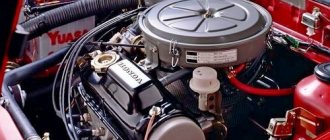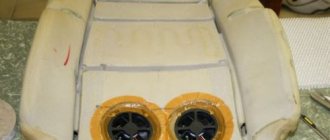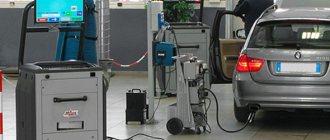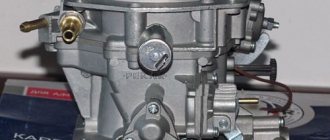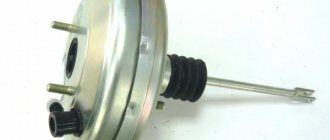In light of recent events in the world, installing an imported pre-heater is becoming more and more expensive for Russians.
The galloping Euro exchange rate puts an end to the dream of many car owners to acquire a pre-heater. Fortunately, there is a way out. We have something to answer to the sanctions!
Recently, the Russian market is increasingly being conquered by domestically produced pre-heaters.
They are produced by the company “Teplostar”
. At first, heaters for trucks were produced, which proved to be very effective in the conditions of the Far North. First, a little history.
In 2001, production of preheaters 04TS, 05TS with a power of 4 and 5 kW, respectively, for passenger cars was started.
Since 2003, pre-heaters “Teplostar 14TS-10”
thermal power of 15 kW are installed on the KAMAZ OJSC conveyor.
In 2005, a branch was opened in the city of Naberezhnye Chelny, Republic of Tatarstan. Today, it is used to assemble Teplostar
, supplied to the KAMAZ OJSC conveyor.
Since 2006, the production of air heaters “Planar 4D”
thermal power 3 kW.
In 2007, the company received a certificate confirming that the quality management system complies with the ISO 9001:2000 standard. The company was also recognized as the best supplier of KAMAZ OJSC. In 2009, the company received a certificate confirming that the quality management system complies with the ISO/TU 16949:2002 standard. , the Planar 44D air heater is being produced.
thermal power 4 kW.
Since 2010, production of a new pre-heater “Binar-5”
for passenger cars.
In 2011, a production site began operating in the urban settlement. Bezenchuk Samara region. Today, Planar
and pre-heaters
“Teplostar”
and
“Binar”
.
The company has production sites in Samara, Naberezhnye Chelny, urban settlement. Bezenchuk Samara region, which are provided with modern equipment and qualified personnel.
Teplostar pre-heaters have been developed and put into production
,
“Binar”
and air heaters
“Planar”
.
A retail network of dealer companies has been created that distribute the products of Advers LLC and Teplostar LLC throughout almost the entire territory of the Russian Federation, the CIS, the Baltic countries, the USA, Finland, the Czech Republic, and Argentina. The company has positive experience in supplying automobile heaters and heaters to the secondary market and installing them on domestic and imported cars.
All manufactured products have certificates of conformity (both Russian and European), indicating the safety of the products and guaranteeing compliance of the products with regulatory documents.
Eberspacher heaters
(
"Eberspächer"
) and
Webasto
(
"Webasto"
).
When we began to receive more and more positive reviews about the products of the Teplostar
, in 2012 we decided to test several Russian Binar-5 heaters on the cars of our employees. Fortunately, with such a low cost, there was no end to those who wanted to experiment.
The heaters were installed on SUZUKI GRAND VITARA, MAZDA MPV and BMW X1 cars. The heaters were installed on two cars with mini-timers, and on one – with a GSM module. Today, after 2 years, the heaters are operating normally and have no complaints. Since then, we have supplied quite a lot of heaters from Teplostar.
for trucks and cars, and we can say that there are no more problems with them than with
Eberspächer
and
Webasto
. The heaters are made with high quality and are not inferior to foreign analogues.
We can offer you the installation of pre-heaters “Binar5B”
and
“Binar5D”
at the following prices:
- Pre-heater (diesel or petrol) with installation kit and mini-timer – RUB 19,500.
- GSM module for remote control of the heater – 6000 RUR.
- Installation on a passenger car - from 10,000 rubles.
- Installation on a truck - from 6,000 rubles.
Selling prices may vary slightly due to market conditions.
We can also repair, diagnose or purchase and install an Eberspacher Hydronic
, air heater for any car.
Our installers have been trained by Eberspacher
and have the appropriate certificates. Installation of the heater takes from 1 to 2 days, depending on the make of the car. The cost of installation also depends greatly on the car. On average it is 10 thousand rubles. The cost of imported heaters, alas, is strictly tied to the Euro exchange rate. And, alas, they cost 2-3 times more than our “Binar”. We can also remove the heater from one car and install it on another. In this case, you will have to purchase an additional installation kit. For exact costs, terms and all questions, please call. Thank you.
In conclusion, a little about the heaters themselves and their design.
What does a pre-heater look like and what does it consist of?
Depending on the purpose and principle of operation, a pre-heater can be a device of various sizes and power used to warm up the engine without starting it cold. In addition, it can be used to heat the interior, windshield and wipers. Autonomous equipment includes a boiler with a combustion chamber and radiator, a pipeline system for transferring fuel, pumps pumping fuel and coolant. It also includes a thermal relay that controls the climate system fan, an electronic control unit and a heater start device.
Thermo Top liquid preheater
Diesel fuel heaters
Diesel fuel heaters are designed to dissolve paraffins formed in fuel at low temperatures. They run on a battery; after starting the engine, they can also run on a generator. They are usually divided into bandage-type heaters mounted on a fine fuel filter and fuel line heaters. In turn, fuel line heaters are divided into flow-through heaters, which cut into the fuel system and heat the fuel passing through the heater jacket, and belt heaters, which wrap around problem areas of the fuel line.[6][10]
Thermal accumulators
The principle of operation of thermal accumulators is based on the accumulation of a certain volume of heated coolant in a special thermos, where it maintains its temperature for up to two days. When the engine starts, the contents of the thermos are discharged into the small circuit of the cooling system by a special pump, heating up the bulk of the coolant by 15-20 degrees. Such thermal accumulators are installed, for example, on the American modification of the Toyota Prius hybrid car.[9]
Installation of electrical equipment
If you think that you need to install an engine preheater, it is worth understanding the installation nuances.
The most correct decision would be to proceed from the instructions of the manufacturer of the special equipment. An installation manual is included with each heater. But in practice, sometimes it turns out that it is not worth following all the instructions exactly. Not everything may match due to the design features of the car itself, the specific brand and even modification.
Before installing an electric PPD type, decide on its relevance specifically in your case. After all, not everyone has the opportunity to constantly connect to a 220V network. And if there is no outlet nearby, there is no way to connect and activate the heater.
In order for the installed PPD to satisfy all needs, and also to work for a long time and without failure, it is extremely important to study the design features of your vehicle and compare them with the instructions for installing the heater.
The work is carried out using a pit or overpass. Some manipulations will require gaining convenient access to the bottom of the car. Although mostly you have to work in the engine compartment.
We can give an example only of the universal installation instructions, which indicate the basic steps and actions when connecting and installing an electric engine pre-heater. In fact, installing such systems is much easier than autonomous types of heaters. But there are some nuances here too.
- Start by ensuring your own safety. To do this, disconnect the negative terminal from your battery.
- Next, drain the coolant from the system. Here you will need to crawl under the car, find the drain plug, unscrew it and drain some of the antifreeze, antifreeze or water. If the machine is operated in winter at low temperatures, only high-quality coolant with a maximum freezing point should be filled.
- The supply hoses will be disconnected from the nozzles of the stove and cooling system. In some cases they are cut. Although experts do not recommend using existing hoses. It is better to take those that come with the heater.
- The heater itself is installed between the cylinder block of your engine and the interior heater. Fixation is carried out using fittings, pipes, clamps and brackets.
- The installation is carried out so that the liquid from the block initially flows through the hose into the heater, and then at the outlet enters the small circuit of the cooling system. Thus, the preheated antifreeze will begin to pass through the engine cooling system and the heater radiator.
- After completing the installation work, all that remains is to return the drained liquid or add fresh antifreeze. Make sure that there are no air pockets in the system after replacement.
The optimal solution when purchasing an electric heater is to use equipment with a built-in pump. This will avoid additional installation difficulties that require a specific location of the heater.
But if you choose a heater without a pump, consider several nuances of installing such equipment.
- Try to place the heater at the lowest possible point. Some, if there is free space due to the design of the engine compartment, install the element on the side member.
- The inlet for the heater is fixed near the bottom point of the automobile cooling system. In this case, the output is already attached to the top point.
- The choice of installation location largely depends on the specific make and model of the car. In general, installation is limited only by the design features of the machine. Choose the place that you think is the most optimal. It is only important to ensure reliable fixation.
- The outlet hose must be placed without kinks, kinks or kinks. Otherwise, the likelihood of air pockets forming there increases.
- When starting up for the first time, be sure to remove all air from the system.
In practice, self-installation of an electric preheater does not look like an extremely difficult task. There are simplified models where installation takes no more than 30 minutes of your time.
At the same time, the electric engine preheater has a number of already mentioned disadvantages. If you expect to use the equipment frequently, and the device can be useful at any time and anywhere, it is better to opt for an autonomous engine heating system.
What are the requirements for preheaters?
Along with the general requirements, such as performance, reliability and durability, additional conditions are imposed on engine heaters. First of all, the heater must be effective, providing a high rate of warming up the engine and interior. Moreover, manufacturers have to solve a difficult problem in order to increase the thermal efficiency of the device, but at the same time maintain moderate fuel consumption. Otherwise, the efficiency of the heater will be low, and the costs of its operation will be prohibitively high. Another important requirement is the overall dimensions and weight of the preheater. On the one hand, an increase in heat transfer surfaces increases the efficiency of the device, but the engine compartment of the car is not endless, and the extra weight does not benefit the dynamics. Finally, the last important condition for the preheater is to ensure maximum completeness of fuel combustion. In this case, the device achieves maximum heat output, no carbon deposits appear on the walls of the flue ducts, and the possibility of a fire situation in the vehicle is completely eliminated.
Diesel engine afterheater. General information
Additional engine heating has been developed for modern turbodiesel engines with a high boost ratio. Having such a high efficiency that its own heat flow, the engine is not able to maintain the optimal operating temperature in the cold season.
So, a diesel engine preheater has a similar way of working with a special preheater and heater, which is called “Webasto” among car enthusiasts. Engine heaters are also connected to the cooling system in the machine engine and run on fuel. The heater turns on only when the engine is turned on and the outside air temperature is +5 C or lower. The diesel that burns in the combustion chamber of the afterheater heats the coolant, and the standard car pump is pumped throughout the cooling system and heats the car engine.
Diesel engine afterheaters are very often installed directly on the conveyors of the manufacturing plant. And since the afterheater is created as an actual element of the car engine, work on their maintenance is carried out under warranty in service centers.
It should be emphasized that not all cars have a built-in reheating system, so there are many centers that can retrofit your car.
The diesel engine heater very quickly and efficiently increases the temperature and clearly maintains it while driving. However, there are cases when the reheater fails.
Over many years of experience in car repair and installation, I have compiled a list of all possible causes of breakdowns:
- The glow plugs have failed. One of the reasons is repeated difficulty starting the boiler; because of this, the candle works for a long time and in vain, trying to ignite the mixture.
- The combustion chamber is heavily coked. This is a feature of our fuel. Many impurities mean low fuel quality.
- The fuel priming pump is faulty. Reason: the plunger is jammed or the contact on the pump is bent.
- The air blower into the combustion chamber is faulty. As a result, the inlet to the pipeline became clogged, the motor bearing jammed, and the brush assembly was worn out.
- The heater control unit has failed. Because of this, there is a fault in the wiring.
Additional equipment of the reheater
It should be said that all afterheaters provide engine heating, and accordingly, they are created precisely for this purpose - although they do not provide interior heating. To do this, it is necessary to install an additional set of special equipment, although such are available for some foreign middle-class cars (Audi, BMW, VW). After an inexpensive conversion, you will have your own interior heating!
The cost of additional equipment and installation work, of course, depends on the brand of the car and will average approximately 200 Euros. This work is completed in almost one day. This is much more profitable than simply buying additional heating equipment.
Benefits of having a heater
Preheater on board your car:
- will extend the life of the power plant - excessive “cold” wear of engine parts is eliminated;
- will allow you to further save fuel - when the internal combustion engine is coldly warmed up, fuel consumption is an order of magnitude higher than when it is brought to operating temperature “by the forces” of a liquid heater;
- will save you from the uncomfortable wait for the windows to defrost and the air to warm up in the cold car interior;
- in normal mode, it will provide high-quality heating of the interior in low-intensity traffic mode (congestion, traffic jams) or waiting during cold periods of the year.

